Ah, the humble potato. Fried, mashed, roasted, baked, or (my personal favorite) boiled and served with a knob of butter, spuds are a pantry staple, and the ultimate comfort food.
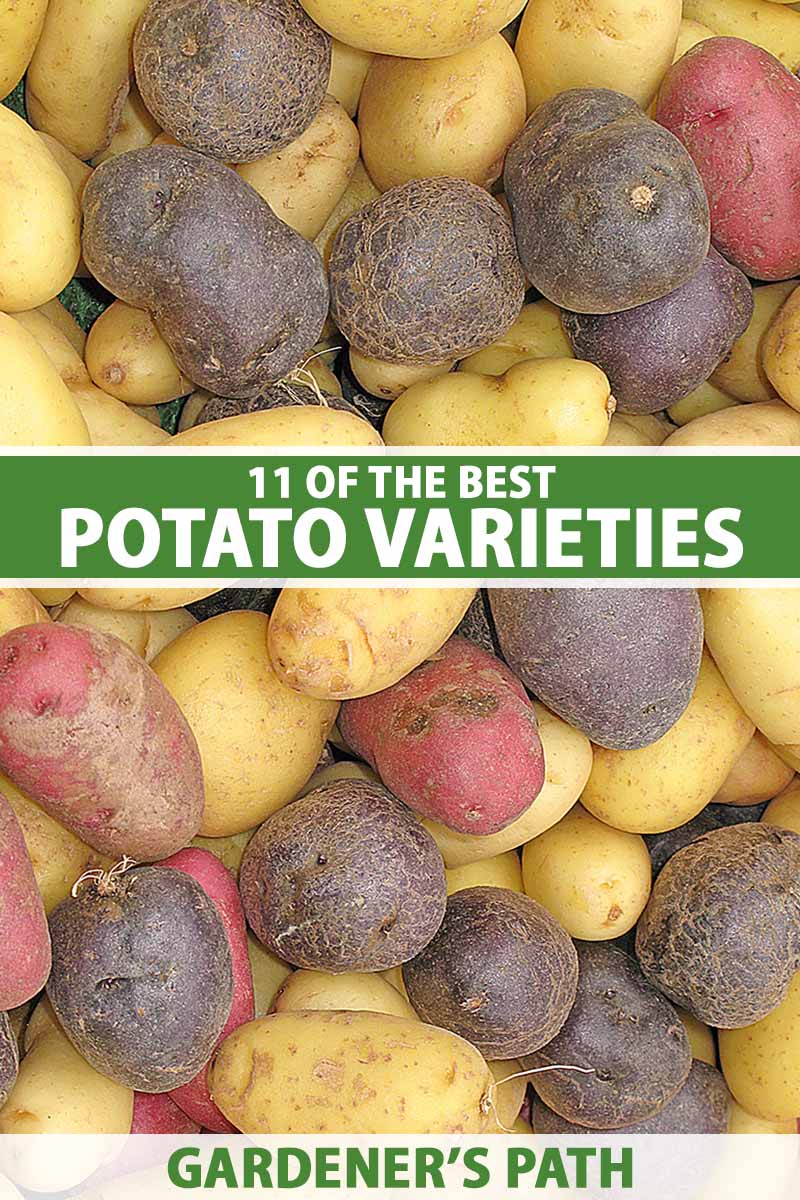
We link to vendors to help you find relevant products. If you buy from one of our links, we may earn a commission.
Some gardeners might question whether growing this cheap and plentiful crop is worth the hassle, space, time, and energy required.
But while it’s true that growing your own potatoes comes with its challenges, there is nothing better than a freshly harvested spud.
What’s more, there are a wealth of varieties out there to experiment with, all of which have different tastes, textures, and characteristics, and behave differently when cooked.
Whether you’re not sure where to begin or you’re already close to narrowing down your final selection of tasty cultivars, take a look at this roundup of the most unique, delicious, and visually appealing varieties of spuds that you can grow in your own backyard for our favorite suggestions.
Best 11 Potato Varieties to Grow at Home
There are a few things to be aware of when choosing which type or types of spuds that you will grow in your own garden:
First, think about what you want to do with your harvest. For example, do you want to make marvelous fluffy mash, the crispiest roasties, or the perfect deep-fried chips?
This might sound like a silly thing to say – surely, a spud is just a spud?
But in fact, each variety comes with its own unique traits and characteristics that mean some are better suited than others for certain uses.
This is because different varieties have different amounts of starch in them, as well as varying levels of sugar.
It’s the level of starch which determines whether the potato is floury or fluffy and breaks down upon cooking, or remains intact with a firm, moist, waxy texture.
The higher the starch content, the more the potato will break down when it is cooked. Potatoes that are high in starch are therefore absolutely perfect for baking and mashing, or for making wedges or fries.

Types with a low starch content, on the other hand, are waxy and hold together well when cooked, making them perfect for use in soups, stews, and salads.
Another top tip when choosing which cultivars to grow is to keep in mind that varieties are categorized loosely in three different groups related to the number of days they take to reach maturity: early, mid-season, or late.
You will also sometimes see these referred to as first earlies, second earlies, and maincrops, with some types that bridge two categories as well, such as a mid-to-late season variety.
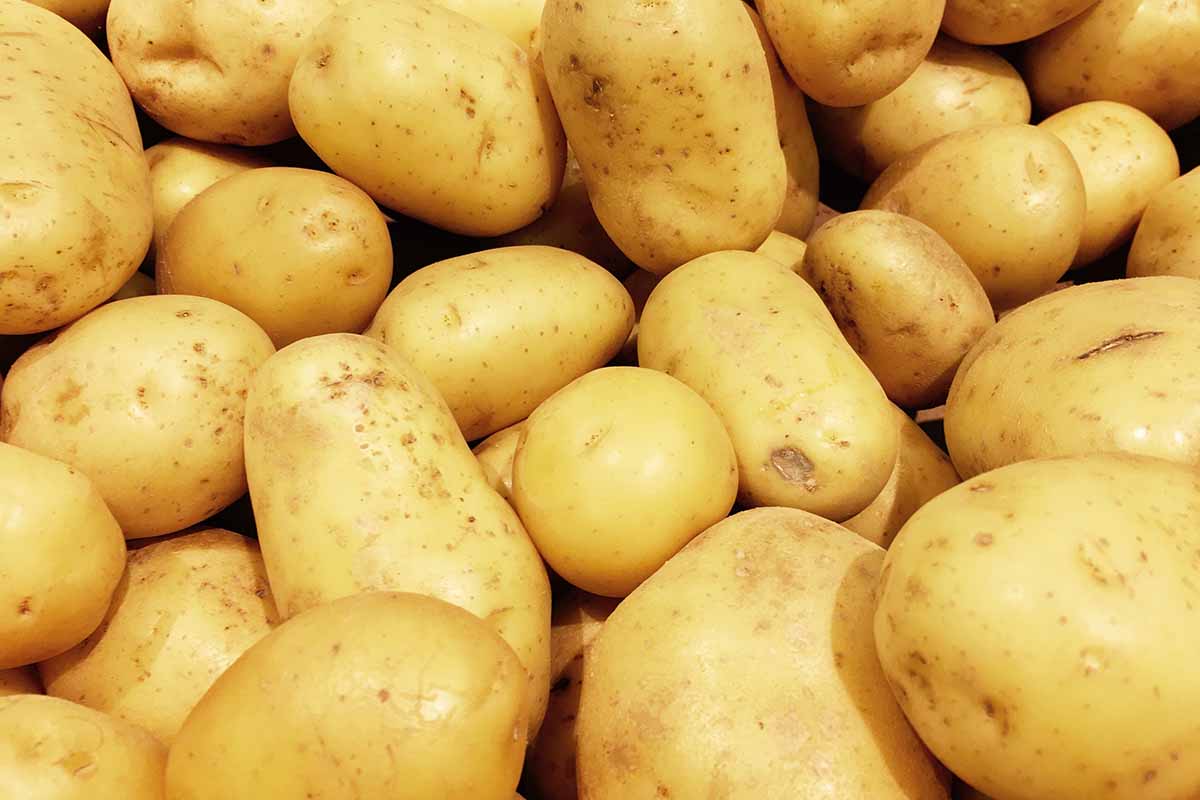
Earlies are, unsurprisingly perhaps, the earliest to mature. They require about 75 to 90 days underground, or sometimes even less time.
Early season plants take up less room in the garden than other varieties, and they are less prone to potato blight, as they are generally harvested before the disease has a chance to take hold.
Mid-season types are up next, maturing in about 95 to 110 days. These are typically ready to harvest around mid-summer.
Late season cultivars typically mature in 120 to 135 days, with some types taking up to 160 days to reach maturity.
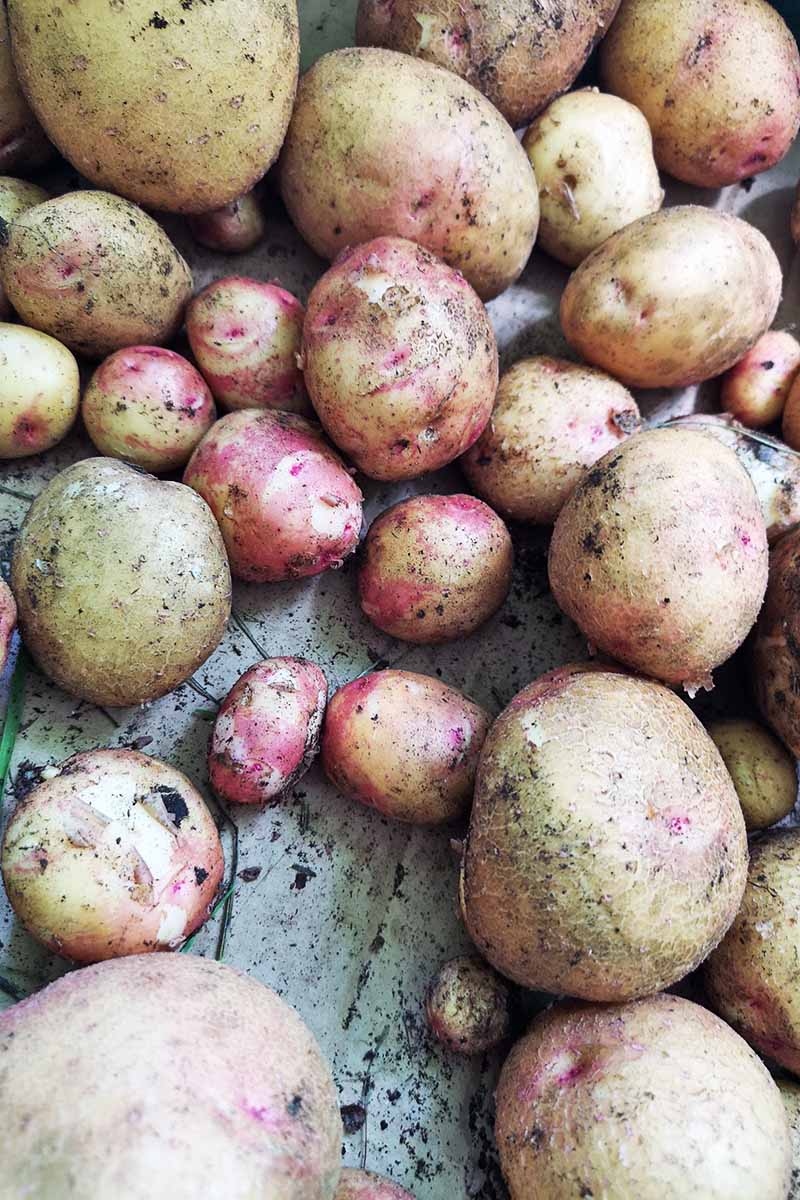
Another difference between these varieties is their size – early potatoes will generally be smaller than maincrop or late season types. But this is not always the case, as fingerling types generally fit into the late season category.
Potatoes referred to as “new” don’t really have their own type, but rather, they are harvested early when they are small.
Whether you’re craving a waxy yellow-fleshed spud, a thin-skinned red, or something white or blue, we’ve got a top pick that you’re sure to love! Time to check out our roundup…
1. Elba
‘Elba’ is a perfect all-rounder, with flaky skin and moist flesh that’s ideal for boiling, baking, and mashing alike.
This cheerful yellow-colored potato is as beautiful as it is vigorous and virus resistant. It’s also resistant to early and late blight, and scab.
This variety is ready for harvesting mid- to late-season, and tubers mature around 90 days after planting.
‘Elba’ is available from High Mowing Organic Seeds and at Gardener’s Supply Company.
2. Kennebec
The ‘Kennebec’ is a very popular all-purpose potato.
With its smooth, thin skin and creamy texture, what’s especially great about this spud is that it maintains its shape when cooked – making it ideal for use in salads, curries, soups, and stews – while at the same time containing just enough starch to be mashed or fried without issue.
You can expect to be eating a lot of potatoes if you grow this variety, as it produces high yields.
Even better, this spud stores well, meaning you can continue to enjoy your harvest many months after the plants have finished producing.
This is an early maincrop variety, ready for harvest in 80 days. It’s resistant to late blight, black leg, and potato viruses A and Y.
You can find ‘Kennebec’ tubers via Burpee.
3. Red Gold
If you’re looking for a unique-tasting tater, look no further.
‘Red Gold’ offers a delicious nutty flavor quite unlike any spud you can find in the grocery store. With yellow flesh and raspberry-red eyes, this is also a very pretty potato.
Hailing from my neck of the woods in Northern Europe, this is an all-purpose mid-season variety that can be mashed, roasted, baked, or fried.
Spuds mature in 90 days. Keep in mind that they are best suited to short-term storage.
You can find this variety on offer at Burpee.
4. Red Pontiac
Another winner in the all-rounder category, this early season red variety comes with the added advantage of having especially thin skin, making it a very appealing choice whether harvested at the new stage or grown to maturity.
‘Red Pontiac’ has waxy-textured flesh, and it is perfect for baking, boiling, mashing, roasting, or especially for use in salads.
This type is not as suitable for frying. The plants are known for having good drought tolerance.
Ready in 80 days, you can find ‘Red Pontiac’ tubers from Burpee.
5. Rio Grande Russet
This is one type that you can enjoy guilt-free!
As long as you eat the skins, this spud is loaded with antioxidants, making it a highly nutritious variety. Russets have a floury, fluffy texture with flavorful skins.
What’s more, this cultivar is high yielding, meaning there’s sure to be more than enough to go around when your harvest comes in.
Thanks to its low starch content, this spud is ideal for salads, slicing, and making into chips.
Producing taters that reach four to five inches in length at maturity, ‘Rio Grande’ has rust-brown skin and white flesh, and is ready in just 59 to 65 days.
You can find this variety at Burpee.
6. Magic Molly
‘Magic Molly’ is an enchanting cultivar that is sure to cast a spell on you.
As rich in color as it is in taste, this type is deep purple both inside and out. And it will even retain that beautiful color when boiled. Prepare to make some culinary magic with this vibrant variety!
This spud comes to life when paired with warm, woody, smoky accents, making it absolutely ideal for grilling on the barbecue.
You will have to wait slightly longer to experience its magic, as this cultivar takes 95 to 100 days to reach full maturity.
You can purchase packages of ‘Magic Molly’ mini tubers for planting from Burpee.
7. Masquerade
Burpee describes this potato as “edible art,” and I couldn’t agree more.
This unique bicolor type really is remarkable. With skin that’s marbled with vibrant purple and white, ‘Masquerade’ is really something that has to be seen to be believed.
A low starch variety, this spud has moist, white flesh perfect for baking, mashing, and roasting, and takes only 63 days to reach full maturity.
You can find ‘Masquerade’ mini tubers for sale at Burpee.
8. Princess Laratte
This is a very popular pomme de terre where I’m currently living in France, to the point that Burpee describes this French variety as a “culinary superstar of European haute cuisine.”
So, what makes this cultivar so popular with the notoriously food-loving French? Well, its flavor is subtly sweet and mildly nutty, almost like a mixture of chestnuts, hazelnuts, and almonds.
This variety is slow to mature, ready in 90 to 110 days, but it is certainly worth the wait.
You can find ‘Princess Laratte’ mini tubers at Burpee.
9. Purple Majesty
As someone who grew up knowing only pale, yellow taters, there is something so irresistibly enchanting about purple potatoes for me.
And I’d be willing to bet the kids and guests who dine with you will feel the same way!
With wine-dark skins and succulent purple flesh, these violet, sweet, buttery spuds add a splash of color and interest to your plate, and they’re perfect for frying.
‘Purple Majesty’ thrives in full sun and matures in 85 days, producing spuds three to four inches long.
You can find ‘Purple Majesty’ tubers via Burpee.
10. Russian Banana Fingerling
This heirloom fingerling type has tender yellow flesh and a rich, buttery flavor.
Excellent pan-fried or roasted, this cultivar also holds up to use in salads. It is noted for high resistance to scab.
‘Russian Banana Fingerling’ is a late-season variety that produces spuds about one and a half inches long. Plants mature in 90 days.
You can find this cultivar at High Mowing Organic Seeds.
11. Yukon Gold
You’ll be sure to strike gold with this super-popular golden yellow cultivar.
Developed in the 1960s in Canada, this hybrid variety has quickly become a firm favorite, thanks to the fact that it offers the best of all worlds – it’s waxy enough to stand up to boiling, but fluffy enough to make a marvelous mash.
That being said, the best way to cook ‘Yukon Gold’ in my opinion is unquestionably via roasting in the oven.
When roasted, it creates a formidable combination of crackly crunch on the outside, and creamy, buttery goodness on the inside – and trust me, I’m English, so if there’s one thing I know, it’s roasted taters!
‘Yukon Gold’ is an early variety, ready in only 65 days, and it requires full sun conditions. This type is noted for its disease resistance, including resistance to scab.
You can purchase ‘Yukon Gold’ tubers for planting from High Mowing Organic Seeds and Gardener’s Supply Company.
You’re Sure to Dig Growing These Spuds!
After seeing all the amazing varieties on offer, you’re practically guaranteed to never think that a spud is just a spud again!
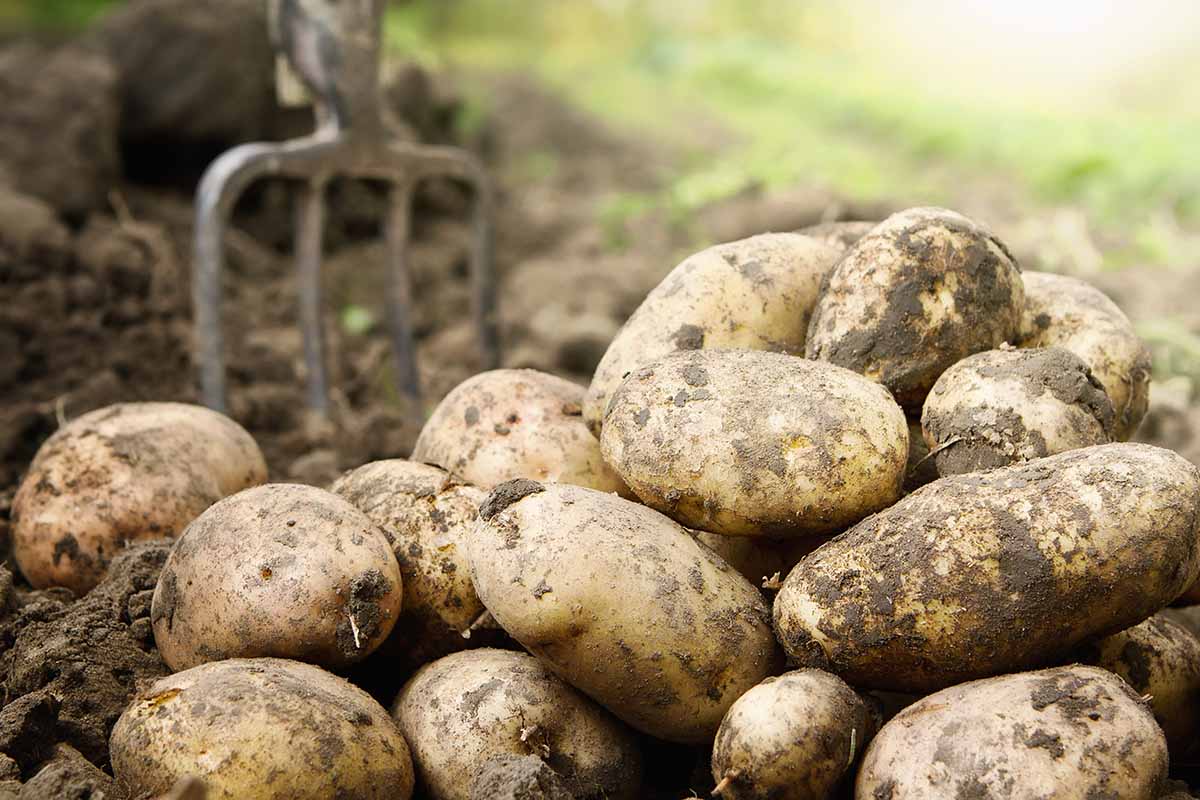
Have you had a go at growing any of these cultivars? Which one is your favorite? Let us know in the comments section below!
If you want to learn more about growing potatoes, be sure to check these out next:
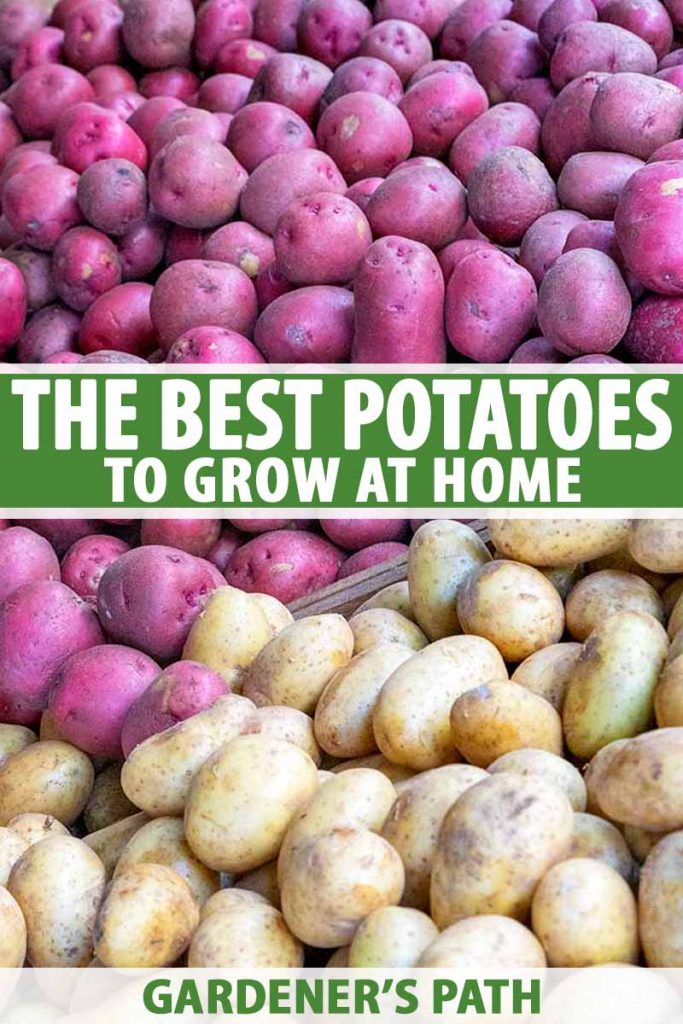
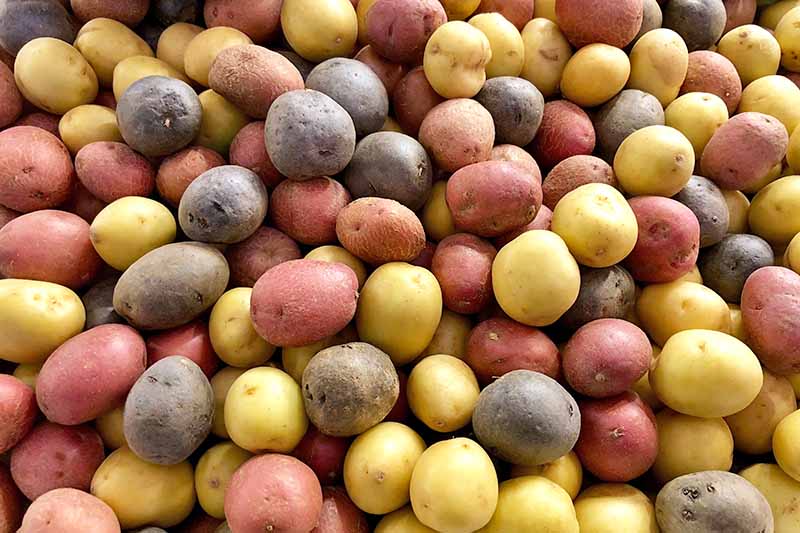


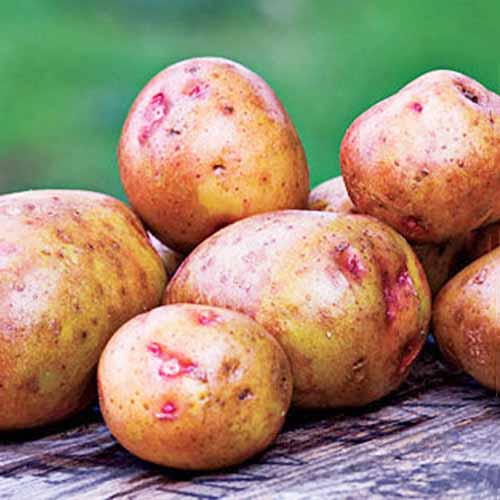
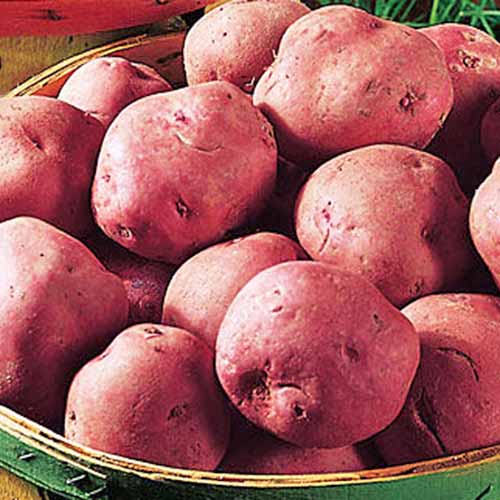
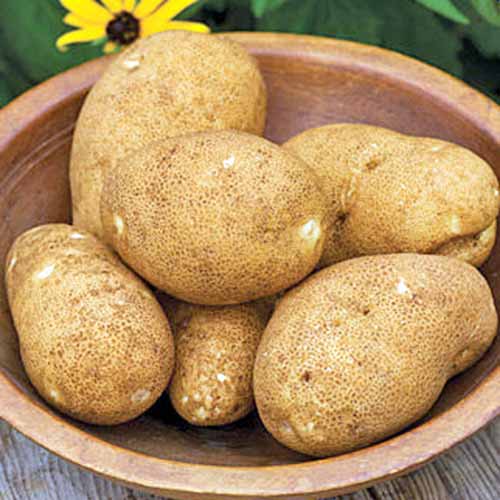
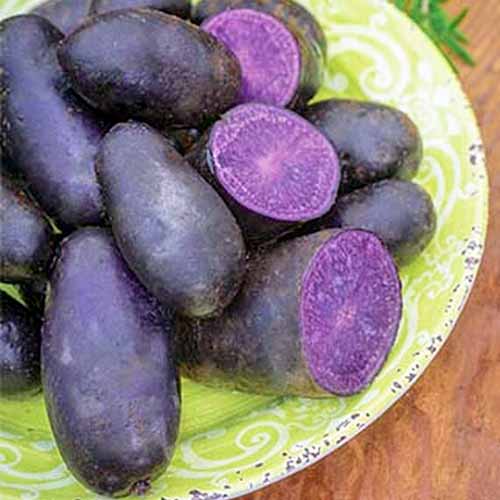
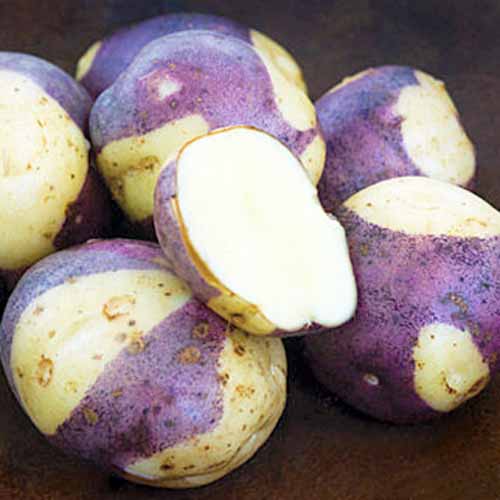
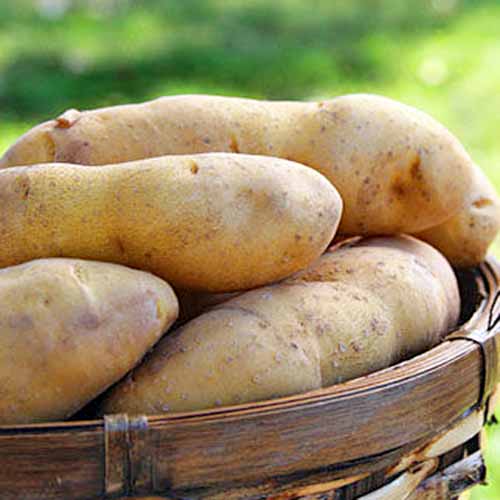
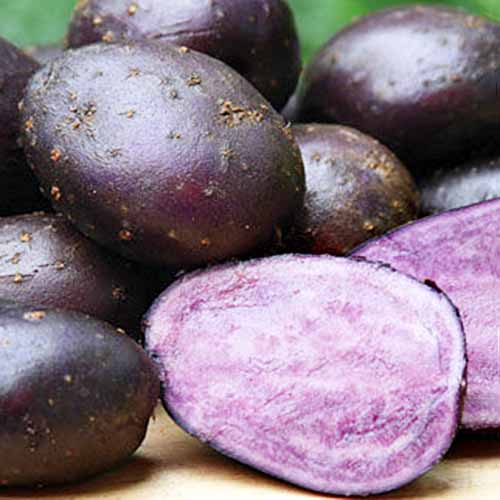
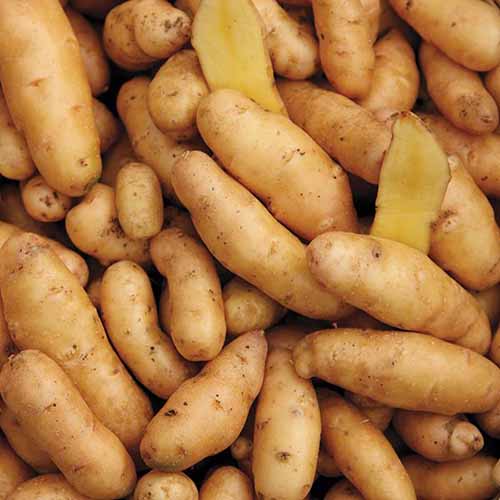
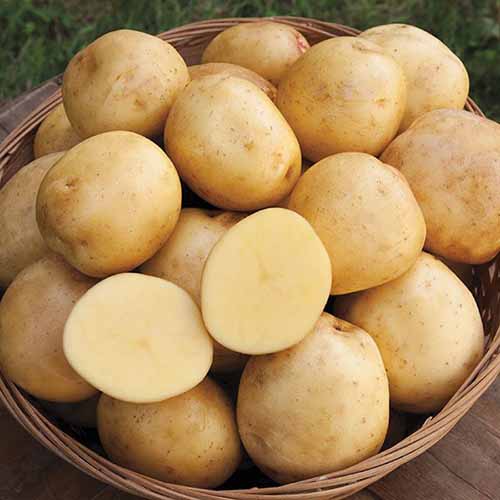
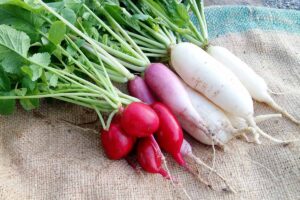
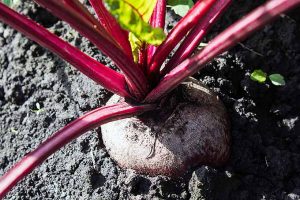
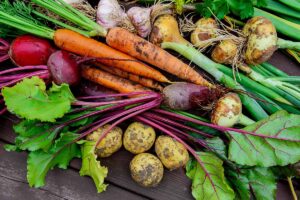
I’ve got a variety of a purple skin and Yukon gold inside flesh, what is it?
There are several varieties with purple skin and golden flesh, including ‘Huckleberry Gold,’ ‘Brigus,’ and ‘Peter Wilcox.’ Maybe one of these is the cultivar that you’re describing?
I have white fleshed potatoes with red eyes. What is their name?
Can you share photos, Linda? What color are the peels?
This is going to be difficult to ID without more information, but they could be ‘Pink Fir Apple,’ ‘Cara,’ ‘Cultra,’ ‘King Edward.’ In some varieties, pink or red coloration on or around the eyes is actually a symptom of a disorder known as “pink eye.” This makes the potatoes more susceptible to other diseases, and can lead to losses in storage and poor quality.
I have found it impossible during the last 10 years or so to find seed potatoes that produce the freshness and taste I’d so much enjoyed previously. Fellow allotment colleagues say the same. Is it because potatoes are now grown for quantity not quality? The same applies to bought potatoes – Jersey Royals in recent years have been diabolical. I’ve tried various seed potato firms all without success.
Ken Gregory, I hate that your old favorite seed potatoes just don’t taste the same. There’s probably a good chance that growers don’t offer as many of the heirlooms anymore, and are focusing on spuds that offer the biggest harvests. I would suggest trying some of the early or “determinate” varieties, if you want to give it another go. They aren’t known for producing big yields, since the plant flowers and dies after producing a lone layer of tubers. It could be that these varieties with more modest yields have a taste you’ll prefer. Also, can you let me know… Read more »
Why does no one ever discuss whether a particular variety or cultivar of potato is determinate or indeterminate? I makes a difference in the growing technique (particularly whether to “hill” the plants or not)
I certainly agree that which potato varieties are determinate or indeterminate is a topic that doesn’t get enough attention, Lonnie Seistad. For those following along who weren’t aware, some types of potato are indeterminate, just like their fellow nightshades, tomatoes. That means they continue to keep producing over the course of the season. They’re the types people grow in bags or boxes, piling more soil on top as the leaves grow to a certain height, and then harvesting several layers of potatoes at the end of the growth cycle. As for the determinate varieties, they stop growing after they produce… Read more »
I always use RUSSETS to make mashed potatoes. I just don’t think the “others” mash as well.
Where can I get Moe Moe Maori potatoes?
Hi there, depending on where you are, you can sometimes find seed Moemoe potatoes at Mitre10 or Bunnings, though it’s a bit hit or miss. Wairere Nursery in Hamilton appears to have them in stock.
I have had good success over the years with yukon golds and red pontiacs which both store very well in the ground. But what is the closest seed new potato variety available in the USA to Jersey Royals or Swift, and where can I get them?
Both of these are early varieties, often harvested when they’re small. But if you’ve had a true ‘Jersey Royal’ grown in Jersey, most aficionados will tell you it’s impossible to truly replicate the flavor of this cultivar unless it’s grown in the native soil and salt air of the Channel Islands, and fertilized by local seaweed. I won’t be so bold as to make a direct comparison to a US cultivar as I haven’t tasted either of these UK favorites myself- perhaps some of our other writers and readers can weigh in there. If you’re looking for an American classic… Read more »